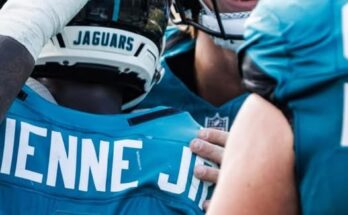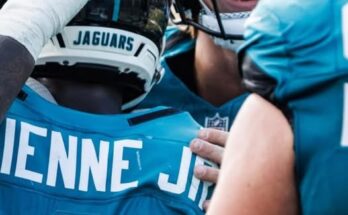Ryan O’Hearn’s Hot Mic Incident: A Look at the Controversy, Impact, and Future of Player Behavior in the Age of Technology
On Monday, during a high-stakes matchup between the Baltimore Orioles and the New York Yankees, an unlikely controversy arose from what seemed like an otherwise routine moment of baseball brilliance. Orioles’ slugger Ryan O’Hearn crushed a three-run home run, giving his team a much-needed edge in the game. However, instead of the usual post-home run celebrations or dugout praise, what caught the attention of fans and media alike was a hot mic incident that exposed a less-than-professional side of the player.
As O’Hearn rounded the bases, his joyous emotions got the best of him, and an expletive-laden phrase was captured by the microphones, a phrase that was soon heard by thousands of viewers and fans tuning into the game. While some might argue that this moment was nothing more than a slip of the tongue in the heat of the moment, it quickly became a topic of discussion, sparking debates on the broader implications for player behavior, the role of technology in sports, and the ongoing scrutiny of athletes in the modern sports world.
It all started as the Orioles took on their American League East rivals, the New York Yankees. The two teams have had a longstanding rivalry, and the intensity of the game was palpable. The tension only grew when O’Hearn, with one swing of the bat, sent a three-run shot over the fence to put the Orioles in a more comfortable lead.
As he jogged around the bases, seemingly thrilled with the impact he just made on the game, O’Hearn’s celebration took a turn when he used a vulgar expression, unintentionally broadcasted through the microphones in the stadium. His words, caught on the hot mic, reverberated across living rooms, bars, and ballparks all over the country.
In the immediate aftermath, the video of O’Hearn’s hot mic incident circulated across social media platforms. Fans, analysts, and the general public quickly voiced their reactions, from outrage to laughter. Some found the moment humorous, reflecting the unfiltered emotions athletes often experience during intense moments. Others, however, were disappointed by the choice of words, questioning the propriety of professional athletes using such language in a public setting.
The immediate fallout from O’Hearn’s hot mic incident sparked a wide range of reactions. Many fans on social media quickly posted clips of the moment, turning it into an internet meme of sorts. Some fans embraced the rawness of the incident, pointing out that athletes are often so caught up in the game that emotions spill over. Others took a more critical stance, arguing that as a professional athlete and public figure, O’Hearn should have been more careful with his language.
The media’s reaction was just as divided. Sports outlets initially downplayed the incident, focusing more on O’Hearn’s stellar performance at the plate and the Orioles’ victory. However, as the story picked up steam, some outlets began to focus more on the aftermath of the hot mic incident, asking if it was appropriate for a player to use such language, especially when it was heard by viewers, many of whom included young fans.
O’Hearn, for his part, later expressed regret for the incident. The Orioles first baseman publicly acknowledged the moment, admitting that it was an unintentional lapse in judgment. In a statement, he said, “I was caught up in the moment. I apologize to fans and to the organization. It was a mistake, and it’s something I’ll be more mindful of going forward.”
Despite O’Hearn’s apology, the incident remained a talking point for days after the game, with many questioning whether or not athletes should be held to a higher standard when it comes to their public behavior, especially in an age where every word and action can be recorded, broadcasted, and instantly shared with a global audience.
In today’s digital age, where every moment of a professional athlete’s life can be documented and shared instantly, the line between personal and professional behavior has become increasingly blurred. Technology has become a double-edged sword for athletes, offering them new ways to connect with fans but also exposing them to heightened scrutiny.
Hot mic incidents like the one involving Ryan O’Hearn are just the tip of the iceberg. Microphones are now placed in virtually every corner of the stadiums, from players’ dugouts to the microphones worn by umpires, coaches, and even players themselves. Broadcasts and interviews are broadcasted across multiple platforms, from national television networks to social media, all of which have an unprecedented ability to reach global audiences.
While these technological advances have revolutionized the way fans interact with the game, they have also made it increasingly difficult for athletes to maintain control over their actions and words. In O’Hearn’s case, an innocent outburst of emotion was caught on a hot mic, and although the moment was likely fleeting for the player, the implications were far-reaching.
Athletes have long been considered role models for young fans, a responsibility that often feels like a weight to carry. While there has always been a level of expectation for athletes to maintain a high standard of behavior on and off the field, these expectations have become even more heightened with the advent of social media and instant broadcasting.
Athletes today are expected to be more than just great players; they are expected to represent their teams, their communities, and their sponsors in the best possible light. This expectation is often reinforced by the lucrative endorsement deals and sponsorships that athletes sign, which require them to maintain a positive public image. In this context, O’Hearn’s hot mic incident could be seen as a lapse in that responsibility, even if it was purely emotional and in the heat of the moment.
Furthermore, the public’s response to the incident highlights a growing divide between those who see professional athletes as larger-than-life figures and those who see them as regular people who are allowed to make mistakes. For some fans, the incident was simply a human moment, one that revealed the raw emotions that athletes feel during intense competition. For others, it was a sign of poor judgment that could potentially damage the reputation of the player and the league as a whole.
While the hot mic incident was certainly an embarrassment for O’Hearn, it is unlikely to have a lasting impact on his career. Professional athletes are known to have a short memory when it comes to moments like these, and as long as O’Hearn continues to perform on the field, most fans will likely forgive the slip-up. However, it does serve as a reminder that even the smallest missteps can quickly escalate into a public relations issue in today’s media landscape.
The Orioles organization will also have to weigh the potential fallout from the incident. While it is unlikely that O’Hearn’s language will affect his standing with the team, the organization may still need to issue some kind of internal reminder about maintaining professionalism, especially in the heat of the moment.
On the other hand, the incident may be an opportunity for O’Hearn to grow as a player and a person, learning how to balance his on-field passion with the awareness that everything he says and does can be captured and broadcasted. This may mean becoming more mindful of his language in future games and, more importantly, using the moment as a chance to connect with his fans in a more meaningful way.
In the grand scheme of things, O’Hearn’s hot mic incident is just one example of the pressures athletes face in the modern era. The scrutiny placed on athletes is immense, and while the public often demands that they be perfect role models, the reality is that they are still human beings who make mistakes.
However, this incident also serves as a valuable lesson for athletes, teams, and fans alike. It’s a reminder that technology, while it enhances our ability to enjoy sports, also places athletes under constant surveillance. It also underscores the importance of accountability. For O’Hearn, acknowledging his mistake and apologizing was the right step in maintaining his relationship with his fans, the media, and his team. But the broader takeaway is that the standards we hold athletes to should reflect both their unique position in society and their humanity.
As we continue to navigate the complexities of professional sports in the digital age, the Ryan O’Hearn hot mic incident is a reminder that while players are under intense pressure to perform, they are also under scrutiny to represent their sport in a manner that reflects well on themselves, their teams, and the game itself.
In the end, Ryan O’Hearn’s three-run home run will be remembered by fans, but so too will his unintentional hot mic incident. Both moments, while vastly different in tone, showcase the intersection of athletics, technology, and the ever-evolving expectations of public figures in a world that demands transparency and accountability at every turn.


